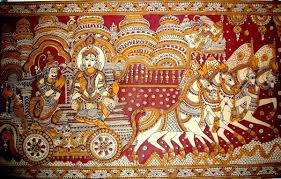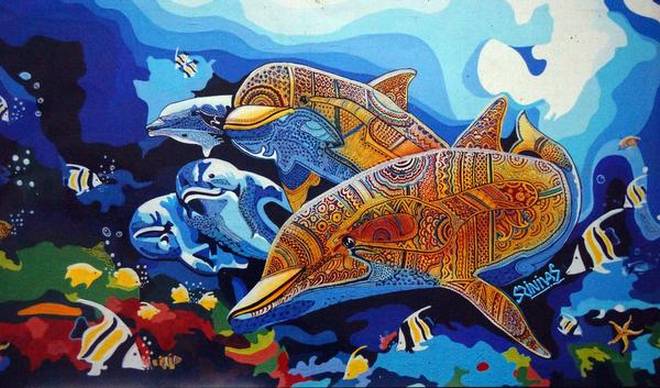Kalamkari is an esteemed traditional art form that has its roots in India, known for its aesthetically finer details. The word “Kalamkari” can be broken down into two words i.e. Kalam and Kari, where kalam is called to be a pen and Kari means work. Thus this form of art focuses on penwork of the Kalamkari artists who spice up the common outlines with their intricate designs. Kalamkari includes both the techniques in the making of the art, painting as well as printing.
Kalamkari art’s unique feature is that it is well-known for the most organic process for its art-making process. The paints are made using the natural elements from our environment such as from parts of plants like roots, branches, leaves and flowers, and later mixed with elements such as copper to add deep artistic value and maintain the colours for a long time.
Recommended Story – Madhubani Paintings
Kalamkari was known as “pattachitra”, where Patta means fabric and Chitra means painting. This was when the Sultanate ruled over the southern part of India, and in turn, gave Kalamkari as art a symbolic identity. Thus, the Sultanate helped Kalamkari to rise in this distinctive form of art that it is known as today.
History of Kalamkari
The history of Kalamkari runs as deep as the details on its canvases.
In ancient times, every kingdom’s court had a set of artisans who would narrate the epics from Hindu mythology to the whole court through their beautifully vivid and intricate illustrations. These artisans were then known as chitrakars, and these chitrakars would also go from one kingdom to another to narrate the stories they heard in every village and amuse people with their fine talent. You can find some of such canvases that date centuries back, thus giving us evidence that Kalamkari is an art form with its own legacy.
Kalamkari found its glorious peak in the Sultanate period in the southern part of India. The Sultanate kingdom always had an eye for intricate art and thus always had a liking towards Persian art. Slowly, the Kalamkari art started showing the influence of Persian art on its art pieces. The colour blue started to pop on the canvases of Kalamkari. The designs became more intricate and a pattern of the monochrome scheme and vivid colours was prominent.
In the middle ages, Kalamkari started inducing hand block printing technique in the art-making process. Many people incorrectly referred to any type of hand block printing with Kalamkari art whereas, it only involves making basic outline patterns with the help of hand blocks and them filling the details with a pen.
Recommended Story – Tanjore Paintings
During the 18th century when India was colonized by the Britishers, this art form became widespread haute couture among the Britishers. They would use the fabrics with intricate Kalamkari details as a decorative form of garment.
Different Styles in Kalamkari
There are certain styles that became famous when people started experimenting with kalamkari. Some of these are as follows-
Masulipatnam style
Kalamkari art found its peak during the Sultanate period, meaning they hold great influence in the way this art form has evolved through history. They gave a new style to traditional Kalamkari with the influence of Persian art, adding their sinuous motifs and designs. They also introduced hand blocks as a technique in the art-making process. They made outlines and main features of the painting with the help of hand-blocks, and later filled the ornate details with a pen.
Sri Kalahasti style

Sri Kalahasti style is mainly seen in the temple region. This style was originated to depict epics of Hindu mythology, Ramayana and Mahabharata. Thus this style mainly focused on mythological gods and goddesses.
Karrupur style
Karrupur style originated in the Thanjavur region of India, and this style combined Kalamkari art with garments. They would make intricate gold brocade designs on the woven fabrics, making your regular garments more elaborate in style. This was typically worn by the royal families in that region and was recognised as a symbol of superior royalty.
Kalamkari in Recent Years
Currently, Klamakari as an art form is slowly vanishing. People have
developed a stigma in art where they find minimalism as a more aesthetic form.
This influence of contemporary art is affecting the legacy of traditional folk
art.
But recently a man from Visakhapatnam, K Srinivas Rao, rejuvenated this art form. He twisted the traditional look and made it more relevant for recent times, something that the people of the generation would relate to with their aesthetic leaning towards minimalistic art approach. Kalamkari’s common subjects incorporated Hindu mythological gods with intricate details, and Srinivas spun this traditional religion-centric art into the awareness for aquatic animals. Thus, he drew in subjects like Dolphins, coral reefs and also animals such as deers. Srinivas said that he always had a keen interest in Kalamkari as an art form, but he wanted to stand out from the already created legacy of thousands of fine artisans. Now, he has a number of art shows where his art pieces are sold for thousands of dollars.
Recommended Story – Miniature Paintings In India










